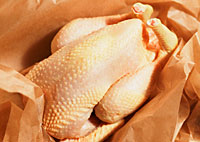Campylobacter contamination still present in chicken | Food Safety Lawyer

An industry round table discussion hosted by Catherine Brown, Chief Exeuctive of the FSA on 2nd September 2013disucssed methods of reducing campylobacter with 12 senior executive from leading UK poultry producers, processors and retailers.
About Campylobacter
Campylobacter is the most common cause of food poisoning in the UK. It is considered to be responsible for around 460,000 cases of food poisoning, 22,000 hospitalisations and 110 deaths each year and most of these cases come from poultry.
Campylobacter is also found in red meat, unpasteurised milk and untreated water. Although it does not normally grow in food, it spreads easily and has a low infective dose so only a few bacteria in a piece of undercooked chicken, or bacteria transferred from raw chicken onto other ready-to-eat foods, can cause illness.
No reduction in contamination levels
FSA monitoring had shown no change in cmpylobacter contamination levels in fresh chicken at the end of the slaughterprocess since 2008. The meeting was convened to clarify that it was ‘unacceptable for this situation to continue’and to explore what more these businesses could do to reduce levels of campylobacter on poultry.√جª¬ø
The industry representatives expressed a strong commitment to solving the problem and a willingness to invest further time, effort and money to act on their responsibility to help solve the problem, and to identify and implement effective methods to reduce levels of campylobacter in the food chain, on a collaborative and individual basis.
Joint Working Group.
The FSA is working in partnership with the industry and Defra as part of a Joint Working Group on campylobacter. The working group is developing a Joint Action Plan, which will help identify and implement interventions that will reduce campylobacter. To contribute to this work the Agency is also funding new research in collaboration with the Biotechnology and Biological Sciences Research Council (BBSRC), Defra, the Northern Ireland Department for Agriculture and Rural Development and the Scottish Government, the research forms part of a joint strategy entitled: UK Research and Innovation Strategy for Campylobacter (UK RISC) in the food chain. 
The working group met recently on 12 – 14 March 2014. It seems that a new target has been set for the industryto reduce the numbers of those most contaminated birds in UK poultry houses from 27% to 10 % by 2015. The BBSRC paper ‘UK Research and Innovation Strategy for Campylobacter in the food chain 2010- 2015 howeversets out the nature and scale of the task ahead.
The complex ecology and biology of the organism mean that that the development of effective risk reduction strategies are ‘a major challenge for Government’, livestock producers, processors and retailers. Further, it has been clear for several years that no one intervention will provide even a partial solution. A multidisciplinary approach which seeks to intervene at a variety of points in the food chain is required.√جª¬ø
The FSA are to test 4,000 supermarket chickens over the next 12 months as part of a survey which will underpin theresearch that is planned. The FSA intend to test chickens from ‘housed’ as well as ‘non housed’ production(i.e. free range facilities where the chickens are free to graze rather than those reared in factories). This should at least indicate whether or not the spread of the food bug is related to the method of production.√جª¬ø
One initiative that has been outlined is a sucessful trial of rapid surface chilling technology by Bernard Matthewsand Faccenda, which has led to a significant reduction in campylobacter levels while staying within current legal requirements around temperature controls in fresh chicken which is expected to be rolled out on a commericalscale.
Food Safety Week June 16 – 22 2014 ‘Dont wash raw chicken’√جª¬ø
Despite the complex and serious nature of the challenge facing the industry, it seems that a diversionarystrategy has been adopted, to persuade consumers that the solution lies within their hands rather thanat the source of the problem.
Following research by the FSA that showed that 38% of consumers who responded said that they alwayswashed chicken and 58% said they washed chicken some of the time, Food Safety week will concentrateon letting people know that the best way to prevent food poisoning is not to wash chicken. [Posters are available from the FSA publication line on 0845 606 0667].
Jeremy Barnett is the head of Regulatory at St Pauls Chambers Leeds and is currently instructed to prosecute two cases relating to food packaging and labelling on behalf of Redcar and Cleveland Council.
Originally posted 2014-03-19 00:00:00.


